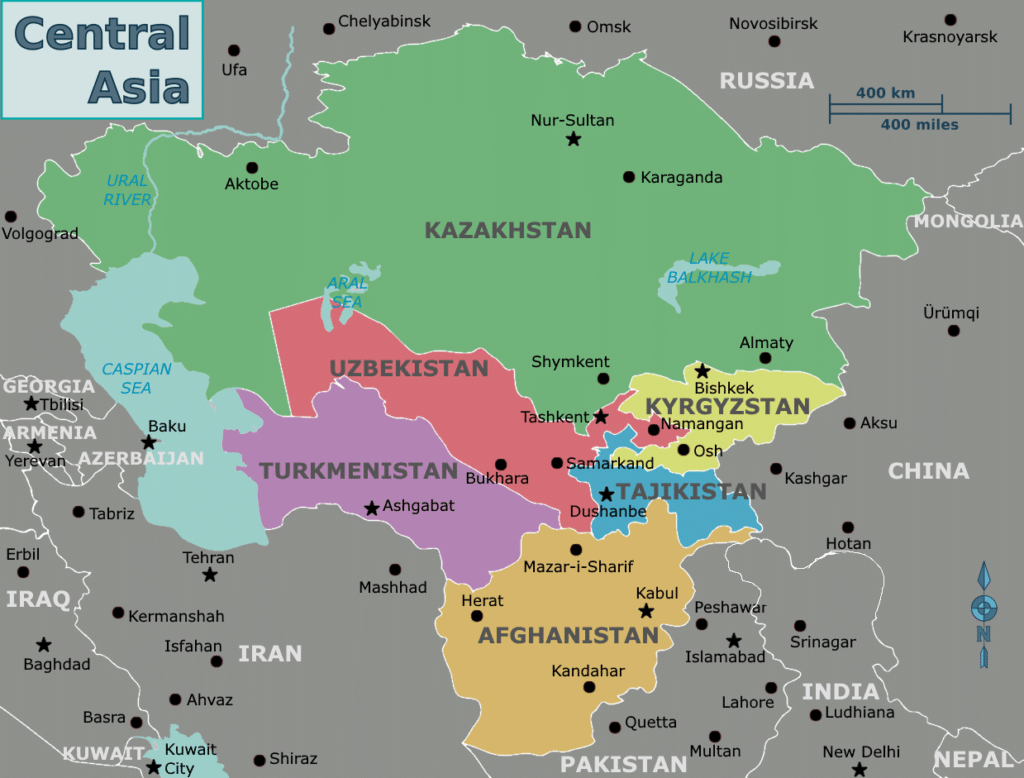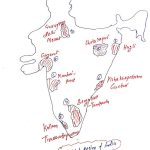
Central Asia is made up of five Republics, which became separate countries when the Soviet Union broke up in 1991. Republic of Kazakhstan, Kyrgyzstan, Tajikistan, Turkmenistan, and Uzbekistan are the five countries that make up this group. But some people include Afghanistan, Mongolia, and the Chinese regions of Tibet and Xinjiang because they are all in the same area and have similar cultures or ethnic groups.
These countries have economies that are in change, and they are going through a hard process of liberalisation.
privatisation. All of these countries’ political systems are led by a strong president and weak legislatures and courts. Democracy hasn’t taken hold yet, and people in the area are still trying to figure out who they are as a country.
Because of where it is, the area is important from a geostrategic point of view, but it lacks direct
access to the sea, which makes it easy for its neighbours to threaten it.
Table of Contents
- 1 Historical Background
- 2 Great Game
- 3 How important the Relations are
- 4 India is an important place for the Central Asian area because:
- 5 The Central Asian area is important for India because:
- 6 Policy to Link Central Asia
- 7 Where we work together
- 8 Energy
- 9 Defence and Safety
- 10 Agreement on Shanghai Cooperation (SCO)
- 11 • What’s in it for India?
- 12 Development Cooperation
- 13 Possible trade and investment
- 14 Weak Power
- 15 Connectivity
- 16 Problems in the Relationships
- 17 Way Forward
Historical Background
India and Central Asia have had a lot of friendly interactions in the past. People, things, and ideas have moved back and forth between the two places, and there have even been spiritual connections that have made us both better. The relationship between the two areas goes back to ancient times, and each era since then has brought some kind of change to the area. The following ties show the connection:
• India has been in touch with Central Asia since the Indus Valley Civilization, which had ties with the old Turkmenistan Civilization.
• Some historians say that the Aryans came from middle Asia to India.
• Before Islam came to Central Asia, Buddhism was the most common religion there.
• The old Silk Route linked China to the markets in Europe. It went through Central Asia, and India was one of the places it went through. So, the two places have had business ties since the beginning of time.
• Parts of both areas were once part of ancient kingdoms, such as the Kushana Empire.
• A lot of the people who ruled India, such as the Greeks, Shakas, Kushans, Huns, and Mughals, came from or went through Central Asia.
• The competition between the British, who invaded India, and the Russians, who took over central Asia, stopped people and ideas from moving between the two places. The name “Great Game” is often used to describe this competition.
Great Game
Historians use this term to talk about a political and military conflict that happened between Britain and Russia over Afghanistan and other parts of Central and Southern Asia for most of the 1800s.
How important the Relations are
India and the Central Asian region have a lot to gain from each other, and strengthening the ties between the two countries will be good for both of them.
India is an important place for the Central Asian area because:
• India’s active position in the area will help make the whole Central Asian region more stable and help it grow.
• Countries in Central Asia want to change up their strategic alliances and play a bigger, more independent role in the area.
• Central Asian countries could also benefit from India’s technological and economic potential because it has a lot of skilled workers in areas like IT.
• If Central Asia wanted to change how it exported hydropower and energy, it would be the same as if India wanted to change what it brought in.
• India’s skilled workers and technology progress, especially in IT firms, can help the service sector of the region grow in a big way.
The Central Asian area is important for India because:
• Central Asia is strategically placed as a gateway between Europe and Asia, and it has a lot of trade, investment, and growth prospects.
• The area has a lot of natural resources, like crude oil, natural gas, cotton, gold, copper, aluminium, and iron.
• India is one of the biggest places that buys and sells energy. Almost two thirds of the country’s oil needs are met by imports. Central Asia and the Caspian area are becoming more important as sources of oil and natural gas to meet this demand.
• The Central Asian Region is an important part of building strong defence ties by focusing on military training to improve strategic and security cooperation. But this security cooperation is limited by geography. Central Asia is not a direct neighbour of India, and the trade route has to go through either Pakistan or Afghanistan, which are both dangerous and unstable.
The fight over energy supplies in Central Asia is getting worse, and India’s economic and political power is growing, so it is important for India to pay more attention to Central Asia. For these reasons, India announced the “Connect Central Asia Policy” in 2012 at the first meeting of the Track II plan of India-Central dialogue in Bishkek, Kyrgyzstan. This policy is meant to speed up India’s relationships with the Central Asian states.
Policy to Link Central Asia
The Connect Central Asia Policy is a wide-ranging plan that looks at political, military, and economic issues.
and links between cultures. The policy has some of the following parts:
• Exchanging high-level visits to keep building on strong political relationships.
• Improving strategy and security cooperation, such as working together to fight terrorism.
• Using the synergy of joint efforts in existing forums like the SCO, the Eurasian Economic Community (EEC), and the Custom Union to increase multilateral involvement with Central Asian partners.
• The medical field is another area with a lot of room for cooperation, and India should build public hospitals and clinics in Central Asia to make this cooperation even stronger.
• When it comes to schooling, India is a cheaper place to go than universities in the West. So, India would like to help set up a Central Asian University in Bishkek that could become a world-class centre of learning in areas like IT, management, philosophy, and languages.
• The goal of the policy is to set up a Central Asian e-network with its centre in India so that all five Central Asian States can join to tele-education and telemedicine.
• India could be a better and more cheap business partner in the building and infrastructure industries.
• The lack of a good banking system in the area is a big problem for trade and business. If the policy situation is good, Indian banks can grow their business.
• Connectivity in the air is another place where people can work together.
• People to people contacts are another very important part of the scheme.
India’s Connect Central Asia Policy is in line with the country’s general plan to get more involved in Eurasia, improve relations with China, Pakistan, and Russia, and expand its ties with these countries. One of the most important ways to work together is to make it easier for people to get around. This is what the International North-South Transport Corridor is trying to do.
________________________________________
Where we work together
Energy
• Energy is the most important place where people should work together. There are many forms of energy in the CAR countries.
• India’s first civil nuclear partnership was with Kazakhstan. Since 2010, Kazakhstan has been sending nuclear fuel to India’s nuclear plants.
• The TAPI project is important because it will build a natural gas route from the Caspian Sea in Turkmenistan to India via Afghanistan and Pakistan. This will connect Central Asia, which has a lot of energy, to South Asia, which doesn’t have enough energy.
• It has a lot of oil and gas fields, both on land and in the Caspian Sea. About 4% of the world’s natural gas reserves and 3% of its oil reserves are in the Caspian Sea.
Defence and Safety
• It is important for India’s peace and economic growth that Central Asia is safe, stable, and doing well. Central Asia is in our “extended neighbourhood,” which means that we should pay much more attention to it than we have so far.
• India and the countries of Central Asia both care about the security of Afghanistan and the fight against terrorism.
• Every year, India does defence drills with some countries in Central Asia.
“Khanjar” is a military practise that India and Kyrgystan do together every year.
“Kazind” is a military practise that India and Kazakhastan do together every year.
Agreement on Shanghai Cooperation (SCO)
• India just joined the Shanghai Cooperation group (SCO), which was started in 2001 and is a political, economic, and military group in Eurasia. India will be able to do what it needs to do to help stabilise the situation in Afghanistan, which is getting worse because the Taliban are getting stronger.
• What’s in it for India?
It gives China and Pakistan another place to talk and work together, which helps build trust.
It will help India reach its goal of having an active role in its wider neighbourhood and stop China from getting more and more powerful in Eurasia.
India will have a chance to do what it needs to do to help stabilise the situation in Afghanistan, which is getting worse because the Taliban are getting stronger.
India’s Connect Central Asia strategy calls for promoting economic integration between India and the Central Asian republics. The group’s members have a lot of energy supplies, like hydrocarbons and uranium.
If India joins the Eurasian Economic Union (EEU), that will be a good thing that will make this partnership even better.
Development Cooperation
• Lines of Credit have been a big part of India and Central Asia’s economic cooperation. These loans have helped pay for construction and manufacturing projects.
• The Indian Technical and Economic Cooperation (ITEC) Programme teaching programmes, which began in the early 1990s, are still going strong in the area.
• The Indian Public Sector Units Bharat Heavy Electricals Limited (BHEL) and the National Hydroelectric Power Corporation gave money to Tajikistan so that the Varzob-1 Hydro Power Plant could be fixed up and brought up to date.
• India has put a lot of effort into making sure that local people get basic training and learn new skills.
• There are plans to set up a medical and educational E-Network for the five Central Asian countries. It will be built on the Pan African e-Network, which helps hospitals and universities in African countries with remote medical and educational support.
Possible trade and investment
• As the economies of Kazakhstan, Turkmenistan, and Uzbekistan, in particular, grow, industries like IT, medicines, and tourism also grow.
• India is a leader in these areas, and if they work together more, it will give trade with these countries a new boost.
• India’s biggest trade and business partner in Central Asia is Kazakhastan.
Weak Power
• One of the most important parts of India’s Connect Central Asia Policy has been “people-to-people” touch.
• Many students from Central Asia come to India to go to college because, compared to European and American universities, college in India is much cheaper.
• Since the time of the USSR, people in the area have been very interested in the cultural diversity of India.
• People in Central Asia watch Bollywood films and listen to Hindi music.
Connectivity
• Building the International North-South Transport Corridor (INSTC). INSTC is a network of ship, train, and road routes for moving goods between India, Iran, Afghanistan, Armenia, Azerbaijan, Russia, Central Asia, and Europe.
• Getting involved with the Ashgabat Agreement. The Ashgabat deal is a multimodal transport agreement between India, Iran, Kazakhstan, Oman, Turkmenistan, and Uzbekistan to create an international transport and transit corridor that will make it easier to move goods between Central Asia and the Persian Gulf. In April 2016, the deal went into effect.
________________________________________
Central Asia is home to India and China.
Central Asia has always been a place for “great games,” which have been renamed “New Great Games” in the modern world. This new great game is a reference to a kind of competition between strong countries like the USA, Russia, and China over the energy resources in central Asia.
China’s growing power, on the other hand, is India’s biggest worry in the area. The following are areas that should be worked on to get India more involved in the region so that it can have good relationships with its neighbours and fight China’s growing power.
• Countries in Central Asia are surrounded by land, so they have tried to find ways to connect to markets around the world. China has been a leader in this area, as shown by the rebirth of its old silk route, now called “One Belt, One Road,” and the Kazakh-China gas pipeline. INSTC, which connects India and Central Asia, has been set up as an alternative link to counter this area.
• China’s main goal has been to use Central Asia’s huge mineral resources to grow its economy, to give Central Asia the consumer goods it needs, and to protect itself from “separatism, extremism, and terrorism” that could come from Central Asian territories.
• China has a plan for how to deal with Central Asia. It has given SCO countries a $10 billion grant and other help. Its main goals are to work together on trade, energy, and infrastructure.
• The trade between India and Central Asia is worth about $1.48 billion in 2017-18, while China’s trade is worth $46 billion. So, for India to keep up with China, it needs to grow both its trade with other countries and its trade with other countries in the region.
Problems in the Relationships
Even though they share a lot of history and culture, the friendship hasn’t grown as much as would be ideal. India’s main problem is that it doesn’t have a clear route to Central Asia.
• Russia and China have strong economic and security links with Central Asian countries, making it hard for India to find strategic space in the area.
Growing ties between Russia, China, and Pakistan would make it harder for India to be in Central Asia.
• The International North-South Transport Corridor (INSTC), which would go through Iran, is still not fully built out and needs a lot of money.
• There is no straight way to get to Central Asia. The fastest way for India to get to Central Asia is through Pakistan and Afghanistan. The fact that India and Pakistan are still at odds makes it hard for India to join Central Asia.
• India feels unsafe because Central Asia isn’t as strong as it could be.
• The region’s borders with Afghanistan are very open to terrorists, people who sell drugs, and people who want to make more weapons.
• China is there: The Silk Road Economic Belt (BRI) project includes Central Asia. China had more money than India did, so India couldn’t keep up.
• Pakistan and Afghanistan are making it hard to move forward with the Turkmenistan-Afghanistan-Pakistan-India (TAPI) and Iran-Pakistan-India (IPI) pipeline projects.
Way Forward
• India could use the help of Moscow, which would rather promote multipolarity and stop the growing influence of China in the area than help China get its own way.
• India can make the relationship even stronger by using its soft power, like Buddhism and Yoga, to get its point across.
• People in the area also like Bollywood in the form of new Indian movies and soap shows.
• India has a great chance to show its soft power in central Asia through education and health care.
• To start a defence and security conversation with Central Asian countries and make it stronger.
• There should be a group of think tanks from India and the Central Asian Region.
• India’s strong place in the pharmaceuticals industry, both in terms of quality and price, can help them grow their market share with some focus and aggressive marketing.
• The points in the Connect Central Asia Policy should be carried out with the right amount of money and tools.
















